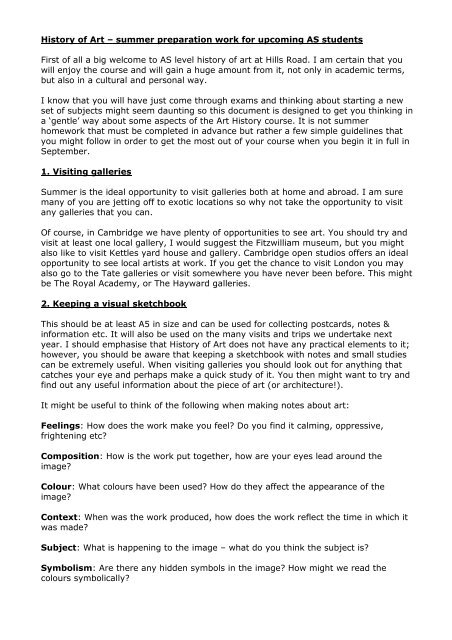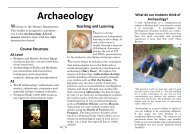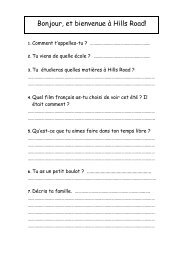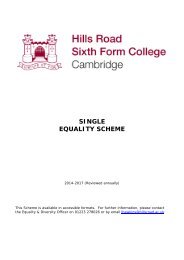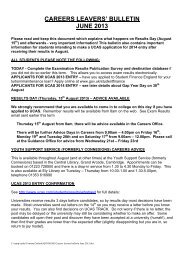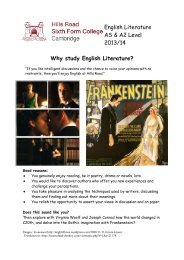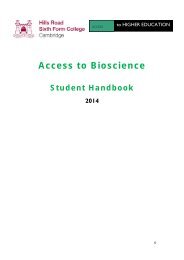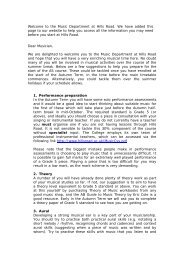History of art - Hills Road Sixth Form College
History of art - Hills Road Sixth Form College
History of art - Hills Road Sixth Form College
- No tags were found...
You also want an ePaper? Increase the reach of your titles
YUMPU automatically turns print PDFs into web optimized ePapers that Google loves.
<strong>History</strong> <strong>of</strong> Art – summer preparation work for upcoming AS studentsFirst <strong>of</strong> all a big welcome to AS level history <strong>of</strong> <strong>art</strong> at <strong>Hills</strong> <strong>Road</strong>. I am certain that youwill enjoy the course and will gain a huge amount from it, not only in academic terms,but also in a cultural and personal way.I know that you will have just come through exams and thinking about st<strong>art</strong>ing a newset <strong>of</strong> subjects might seem daunting so this document is designed to get you thinking ina ‘gentle’ way about some aspects <strong>of</strong> the Art <strong>History</strong> course. It is not summerhomework that must be completed in advance but rather a few simple guidelines thatyou might follow in order to get the most out <strong>of</strong> your course when you begin it in full inSeptember.1. Visiting galleriesSummer is the ideal opportunity to visit galleries both at home and abroad. I am suremany <strong>of</strong> you are jetting <strong>of</strong>f to exotic locations so why not take the opportunity to visitany galleries that you can.Of course, in Cambridge we have plenty <strong>of</strong> opportunities to see <strong>art</strong>. You should try andvisit at least one local gallery, I would suggest the Fitzwilliam museum, but you mightalso like to visit Kettles yard house and gallery. Cambridge open studios <strong>of</strong>fers an idealopportunity to see local <strong>art</strong>ists at work. If you get the chance to visit London you mayalso go to the Tate galleries or visit somewhere you have never been before. This mightbe The Royal Academy, or The Hayward galleries.2. Keeping a visual sketchbookThis should be at least A5 in size and can be used for collecting postcards, notes &information etc. It will also be used on the many visits and trips we undertake nextyear. I should emphasise that <strong>History</strong> <strong>of</strong> Art does not have any practical elements to it;however, you should be aware that keeping a sketchbook with notes and small studiescan be extremely useful. When visiting galleries you should look out for anything thatcatches your eye and perhaps make a quick study <strong>of</strong> it. You then might want to try andfind out any useful information about the piece <strong>of</strong> <strong>art</strong> (or architecture!).It might be useful to think <strong>of</strong> the following when making notes about <strong>art</strong>:Feelings: How does the work make you feel? Do you find it calming, oppressive,frightening etc?Composition: How is the work put together, how are your eyes lead around theimage?Colour: What colours have been used? How do they affect the appearance <strong>of</strong> theimage?Context: When was the work produced, how does the work reflect the time in which itwas made?Subject: What is happening to the image – what do you think the subject is?Symbolism: Are there any hidden symbols in the image? How might we read thecolours symbolically?
Please note that this book will not be assessed as p<strong>art</strong> <strong>of</strong> your history <strong>of</strong> <strong>art</strong> course (butit does form a good reference point for revision.)3. ReadingDon’t panic, I am not setting lots <strong>of</strong> reading but it will be useful to get hold <strong>of</strong> one <strong>of</strong> thekey texts in preparation for the course. When you arrive in September you will be givena number <strong>of</strong> text books, including Gombrich’s ‘Story <strong>of</strong> Art’ and ‘A World <strong>History</strong> <strong>of</strong>Architecture’.However, it is recommended that all students <strong>of</strong> history <strong>of</strong> <strong>art</strong> purchase the followingbook:Honour & Fleming ‘A World <strong>History</strong> <strong>of</strong> Art’This is also a core text (but not provided) and will be extremely useful forunderstanding the topics. A new copy can set you back about £30 but it is okay to get asecond hand one – you might try Galloway and Porter or Amazon Marketplace.You willbe given a full reading list in September so don’t go mad buying lots <strong>of</strong> books! However,do look out for any interesting <strong>art</strong>icles about <strong>art</strong> in journals and newspapers – youmight perhaps st<strong>art</strong> a cuttings collection! You could also read a novel that gives anenjoyable overview <strong>of</strong> a p<strong>art</strong>icular period; try any <strong>of</strong> the following:• Brunelleschi’s Dome by Ross King (Good for Florentine Renaissance)• The Yellow House by M<strong>art</strong>in Gayford (Discusses the turbulent relationshipbetween Gauguin and Van Gogh)• The Girl with A Pearl Earring (On Vermeer) by Tracy Chevalier• The Moon and the Sixpence By Somerset Maughan (relating to the life <strong>of</strong>Gauguin).• My Life with Picasso by Francois Gilot• The Masterpiece by Emile Zola• Light by Eva Figues• Rothko by Glyn Hughes• The Lives <strong>of</strong> the Artists (Volumes I & II) by Giorgio Vasari4. TV & FilmUnusual to find a teacher telling you to watch TV as p<strong>art</strong> <strong>of</strong> your homework!Nevertheless, there are lots <strong>of</strong> programmes on Art (nearly every week there issomething useful – especially if you have Sky and/or Digital). Get into the habit <strong>of</strong>studying the TV guide at the beginning <strong>of</strong> the week and try and st<strong>art</strong> building up yourown <strong>art</strong> history reference library.You might also rent programmes or films on DVD, there are many out there!
5. Visits & TripsThere are many opportunities in <strong>History</strong> <strong>of</strong> Art to visit galleries around the world. Thisyear’s lower sixth residential visit is to Amsterdam and is scheduled to take place inearly December (2 nd – 6 th ). We have included some information regarding this visit aswe are st<strong>art</strong>ing to plan it now and have enclosed a letter which provides more details.We are asking all lower sixth AS <strong>History</strong> <strong>of</strong> Art students to provide a deposit <strong>of</strong>£100 by the 19 th July in order to secure a place. I’m sorry to have to ask for moneyprior to the coutrse beginning, however, if we can book it at this end <strong>of</strong> summer thenwe can take advantage <strong>of</strong> cheaper prices! Whilst the visit is not compulsory it is highlyrecommended. If you have any queries then please contact me on e-mail:twinn@hrsfc.ac.uk6. And FinallyKeep your eyes open, try to think about how the world looks around you and why thingshave been designed in a certain way. All is important for your visual development.Well that’s it for now, above all have a good summer and I look forward to meeting youin August/September. If you have any questions in the meantime then please don’thesitate to contact me.Timothy Winn & Christopher Welander<strong>History</strong> <strong>of</strong> Art


